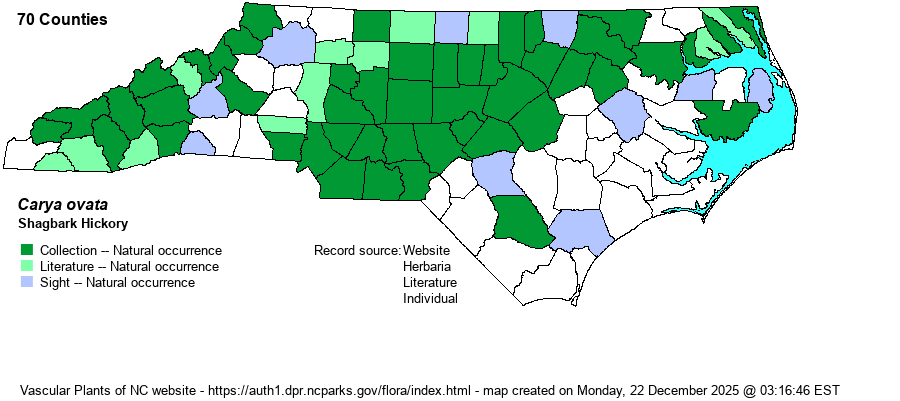| Section 6 » Order Juglandales » Family Juglandaceae |
Show/Hide Synonym
| taxonName | relationship | relatedTaxonName | relatedTaxonRefText | relComments |
|---|
|
|
|
|
|
|
|
|
|
|
| Carya ovata | > | Carya ovata var. fraxinifolia | | | | Carya ovata | > | Carya ovata var. ovata | Fernald (1950) | | | Carya ovata | > | Carya ovata var. ovata | | | | Carya ovata | > | Carya ovata var. nuttallii | | | | Carya ovata | > | Carya ovata var. pubescens | Fernald (1950) | | | Carya ovata | = | Carya ovata var. ovata | Flora of North America (1993b, 1997, 2000, 2002a, 2002b, 2003a, 2004b, 2005, 2006a, 2006b, 2006c, 2007a, 2009, 2010) | | | Carya ovata | = | Carya ovata var. ovata | | | | Carya ovata | = | Carya ovata var. ovata | | | | Carya ovata | = | Hicoria ovata | Small (1933, 1938) | | | Source: Weakley's Flora |
|
| Author | (P. Miller) K. Koch | |
| Distribution | Present over most of the state, but absent to very rare in the southeastern half of the Coastal Plain. Likely is present in all counties in the Mountains and Piedmont, though there are some counties with (as yet) no known records. Few records southeast of Bertie and Johnston counties, and absent from the Sandhills proper.
This is a very wide-ranging species in the East, from southern Canada south to GA and eastern TX, but with no record known from FL. Over much of this range, there are records for all counties, especially from PA, KY, and AR northward.
| |
| Abundance | Fairly common to frequent, and locally common in some areas of rich soil, in the lower Mountains, Piedmont, in the Roanoke River floodplain in the northern Coastal Plain, and the Cape Fear River in the southern Coastal Plain. Much less numerous than Mockernut (C. tomentosa) and Pignut (C. glabra) hickories in NC, but perhaps seen as frequently as Bitternut Hickory (C. cordiformis). | |
| Habitat | This species favors rich soils, often where circumneutral, on lower forested slopes and bottomlands – essentially just brownwater bottomland forests. It is not typically found in most upland oak-hickory forests, unless over mafic rock, where it can be numerous. It is usually found on flat or only slightly sloping ground, and not normally on steep slopes. In parts of the Piedmont, it is usually replaced by Southern Shagbark Hickory (C. carolinae-septentrionalis) in upland oak-hickory forest stands. |
| Phenology | Flowers in May, and fruits in October. | |
| Identification | This well-known species is a tall and majestic deciduous tree, often growing over 100 feet tall. Over most of NC, it is easily separated from all other trees by its very shaggy (loose) gray bark. In the eastern half of the Piedmont, however, Southern Shagbark Hickory has similar bark, and Shellbark Hickory (C. laciniosa) – very rare in the state – can be similar. The latter can be eliminated by its 7-9 leaflets; the other two have 5 leaflets. Shagbark’s leaflets are typically wider/broader than on Southern Shagbark, with the terminal leaflet usually 3 inches wide or wider, as compared with usually just 1.5-2 inches wide in the latter. Also, Shagbark leaflets are usually quite pubescent to tomentose below, whereas Southern is mostly glabrous. Shagbark also has fairly broad twigs and large terminal buds (which are hairy and tan-colored); Southern has slender twigs and a redder-brown terminal bud that is usually glabrous. | |
| Taxonomic Comments | None, other than Southern Shagbark Hickory is often still lumped into this species, usually as a variety but at times not even designated as an entity at all.
| |
| Other Common Name(s) | Common Shagbark Hickory (perhaps a better name than just “Shagbark Hickory” when Southern Shagbark Hickory is used for its “cousin” species – to avoid confusion). Weakley (2018) uses this common name. | |
| State Rank | S4 [S5] | |
| Global Rank | G5 | |
| State Status | | |
| US Status | | |
| USACE-agcp | FACU link |
| USACE-emp | FACU link |

